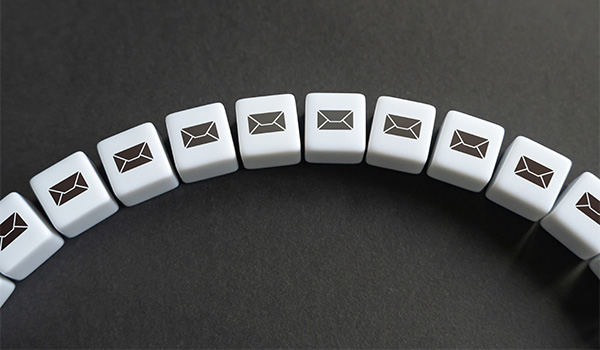Top 11 Mistakes You Should Avoid in Direct Mail Marketing
January 27th, 2024
8 min read

You’re about to invest a significant portion of your marketing budget into a direct mail campaign, so how can you make sure you do it right for maximum impact? And how can you be extra sure you don’t mess anything up along the way?
At Integra, we’ve been answering these questions and many like them for nearly two decades, and we’re excited to share the insight we’ve gained along the way.
Direct mail marketing can offer major benefits to companies in just about any industry, but there are also many chances to misstep throughout the process of planning, designing, printing and sending each piece. We’re here to teach you about the 11 most common of those missteps so you can avoid them in your own direct mail marketing and focus instead on what you do best: successfully earning new business and serving your customer base.
Direct Mail Marketing Mistake #1: Designing a Mail Piece That Doesn’t Stand Out
First and foremost, you want whatever you send to grab attention. If no one ever opens your envelope or reads over your postcard, what’s the point of spending the money?
There’s an easy fix here, and it’s a customizable one. You get to choose size, color, messaging and embellishments on your direct mail piece. Check out some of our tips for making your postcard stand out in the direct mail if you plan to send postcards. Many of the same principles apply with letters, catalogs, flyers and other mail pieces:
- Use eye-catching color
- Consider larger mail piece sizes that stick out past the other mail
- Try embellishments and features to gain interest
The list goes on, and the only real way to fail in this category is to disregard it altogether.
Direct Mail Marketing Mistake #2: Failing to Craft a Compelling Message and Offer
If it’s not clear what the offer of your piece is, your audience likely won’t spend long pondering it. The world is full of clear, concise messaging vying for the attention of your customers or prospects, and they’ll quickly turn from your content if they’re not sure what it’s trying to say to them.
First, make sure you know what it is you want your audience to know. While you probably have lots of good ideas and offers for them, you’ll want to choose a specific message for your direct mail campaign. You can always target other products and services later, so don’t try to fit it all into one mailing.
Next, aim to strike the right balance of visuals and text. The two components complement one another to create a message that’s easy to consume and understand in just a few seconds.
Direct Mail Marketing Mistake #3: Putting Too Much Into One Mail Piece
Buyers get overwhelmed fairly easily, especially when it comes to ads and marketing, which their world is saturated with. If you offer too many options in one postcard or letter, for instance, they may suffer from decision fatigue and opt out of your sales funnel altogether.
The same goes for visual elements. While you want to find a balance between images and text, you don’t want the balance to mean covering 100 percent of your surface with writing and colors. Make sure the design is one that readers can easily scan without getting confused or feeling overburdened.
These guidelines are based on some of the most successful direct mail campaigns we’ve helped run at Integra, and here’s a golden rule: You should never include more than one single call to action per mail piece.
Direct Mail Marketing Mistake #4: Missing the Mark on Your Call to Action
Your call to action (CTA) is arguably the most important part of your direct mail piece. If people don’t know what action to take after they’ve read what you send, they’re most likely going to take no action at all. If they take no action at all, you will have effectively made no progress with your work.
It’s okay to give people multiple ways to respond to your call to action. You might include a:
- QR code taking people to a related landing page on your site
- URL leading to the same landing page as the QR code
- Phone number people can text to receive the URL or a more direct connection to your team
We recommend avoiding too many options, but no matter how many you include, people should know exactly what will happen when they reach out. When you consider your messaging, think about the pain point you’re alleviating for your customers, and clearly state how acting on your CTA will get them past that pain point. Give them a clear path to getting there, and help them visualize where they will ultimately be after they’ve followed through on your proposition.
Logistically, you want your call to action to be clear, direct and concise. Stick with just a few words, and make those words count. It shouldn’t be buried within the rest of your content’s design. There should be no question about your offer, nor about how readers can take advantage of it.
Visually, your logo and your call to action should be the two elements that most effectively draw the eye, popping off the page so that people know who you are and what you’re encouraging them to do with no more than a glance.
Direct Mail Marketing Mistake #5: Sending Your Materials to the Wrong Audience
This point may sound obvious, but we can’t tell you how many times we’ve heard new clients talk about past disappointments with direct mail due to poor audience planning.
The way you choose to mail to your audience will in part decide which recipients get your mail piece. For instance, with Every Door Direct Mail (EDDM), you won’t need addresses, but you’ll need to send a piece to every person in the USPS route you select. On the other hand, targeted mailing differs greatly from EDDM and will require names and addresses for each individual piece.
When it’s time to decide on your ideal audience, consider the different direct mail lists available to you. Make sure you’ve budgeted for a list if you plan to purchase one. If you’re using a house list, check that it’s up to date and reaching active, accurate addresses. With local services, don’t overextend to regions people aren’t likely to travel from. With targeted demographics, avoid the use of too many filters, as you’ll run the risk of cutting your potential audience down too much.
Direct Mail Marketing Mistake #6: Choosing Dates When Mailboxes Are Already Oversaturated
The most successful direct mail campaigns involve multiple mailings spaced out by a certain amount of time, be it two weeks, three weeks, a month or more. As you strategize for the most effective campaign, be sure to factor each one of these mailings into your timeline and adjust to avoid busy mail periods. Some of those periods include:
- Holidays
- Annual regional events
- Major competitor mailings
Depending on your specific audience, you may even want to work around typical vacation weeks throughout the summer months. Do a little digging to determine optimal days for your mail to reach buyers and businesses.
Direct Mail Marketing Mistake #7: Working With a Printer Who Doesn’t Have Direct Mail Knowledge
Lots of businesses make the mistake of choosing separate printers and mail houses. While doing so is a viable option, it’s not in your best interest. If you’re looking to save money, time and effort by dodging mistakes, one of the easiest ways of doing so is with a printer who also handles mailing.
Why would it matter if the two functions are separate from one another?
Because printers with direct mail expertise will learn about your goals and the type of mailing you want to do and help you design based on the required specifications set forth by the USPS. You’ll need to meet size, weight and label criteria to get the postage rates you’re expecting and avoid your mailers being rejected by the post office. The sooner you get a mail professional on your project, the more seamlessly you can integrate these factors into your design to avoid redesigns down the line, so using a printer with mailing expertise just makes sense.
Thinking about reaching out to Integra to harness the knowledge we’ve gained in the direct mail sphere over the years? Learn more about working on a project with us by clicking below.
Even printers who handle mailing can make mistakes if they don’t stay up to date with USPS regulations. Our next point tackles one of the direct consequences we’ve seen people face when they work with printers and mail houses that are out of date on this information.
Direct Mail Marketing Mistake #8: Paying Unnecessary Sales Tax on Your Direct Mail Postage
No matter what kind of business you run, you should always check local laws before you pay sales tax on your direct mail postage. In fact, if your printer or direct mail house incorporates sales tax as a line item in your billing, we suggest you bring it up with them and find out where they source their USPS data.
While sales tax on postage itself is not always required, some parts of mail processing may be taxed based on your locale. Be sure to hold a conversation with your service providers as early as possible to clear up any mistakes and get tax fees removed from your invoice if your state does not require them.
Direct Mail Marketing Mistake #9: Not Tracking Engagement With Each Mailing
One of the most overlooked aspects of direct mail marketing is tracking engagement. It's not just about sending out your materials. It's also about understanding how those materials perform. Without tracking, you're essentially flying blind, unable to gauge the success of your campaign or learn from its results.
To avoid this mistake, integrate tracking mechanisms into your direct mail pieces. Doing so could be as simple as including a unique URL, QR code or tracking phone number. These tools will allow you to monitor how many recipients are taking action after receiving your mail.
One effective way to track ROI more closely is to take advantage of a “direct mail with intelligence” platform like SynergyMail or a similar system. The “intelligence” aspect of this type of program will allow you to make additional impressions on your prospects via digital platforms, as well as track metrics like delivery time and response rate. By analyzing this data, you can adjust future campaigns for better performance, ensuring your marketing budget is being used effectively.
Direct Mail Marketing Mistake #10: Following up With Mail Pieces Lacking in Brand Cohesion
Consistency is key in branding, and this golden rule extends to your direct mail campaigns. Each piece of mail you send should be immediately recognizable as a part of your brand. This mistake often occurs when businesses rush to follow up without considering how the new materials align with their overall brand identity as well as the unique campaign’s messaging.
Ensure that all your direct mail pieces, whether they’re follow-ups or parts of a series, maintain consistent branding. Don’t send exact replicas, but use your brand's color scheme, logo and messaging tone. Cohesive branding not only reinforces your identity in the minds of your recipients but also builds trust and professionalism.
Direct Mail Marketing Mistake #11: Not Following Up at All
The final common pitfall in direct mail marketing is an altogether absence of follow-up. Many businesses send out a single mailing and then stop, missing the opportunity to build on the initial contact. Follow-up mailings can reinforce your message, remind recipients of your offer and increase the likelihood of conversion.
Plan a series of mailings as part of your campaign strategy. They could be sequenced to tell a story, offer additional incentives or provide more information about your products or services. Remember, the key is not to be intrusive but to provide value in each communication, nudging your prospects further down the sales funnel.
Which Direct Mail Marketing Mistakes Have You Been Making?
Maybe you haven’t made a single one of these mistakes in your direct mail marketing, and if that’s the case, we sincerely commend you. Or perhaps you’re about to embark on your first mailing, and you wanted to get a jump on the possible missteps — great job there too.
No matter what position your business is currently in with your direct mail strategy, you know it can be stressful to plan. Eleven is no small number, especially when any one of these issues could tank your response rates.
Fortunately, you now know some of the most common and critical pitfalls, which means you can accurately sidestep them on your next campaign for better business gains. Remember, it's not just about avoiding errors — it's about creating opportunities to connect with your audience and grow your business.
While you’re thinking about your direct mail strategy and how to avoid mistakes, consider learning about top ways to lower your direct mail costs so that you’re staying under your project budget and over your projected conversion rate!
Ready to dive into a well-polished mailing right away? Click below to get started with a print and mail expert from Integra.
Topics:


























